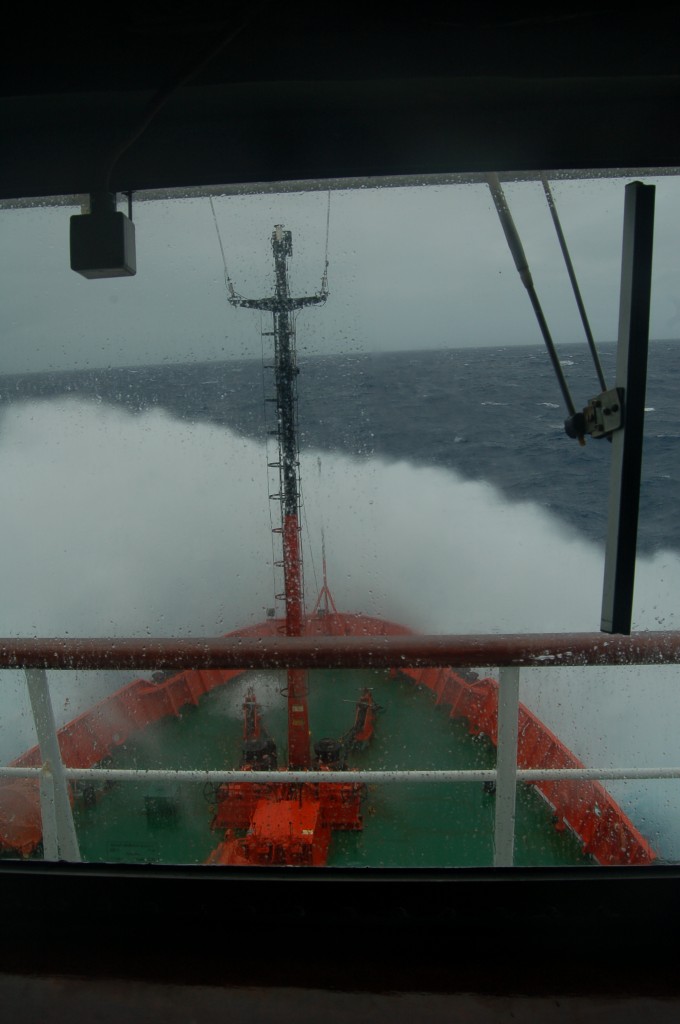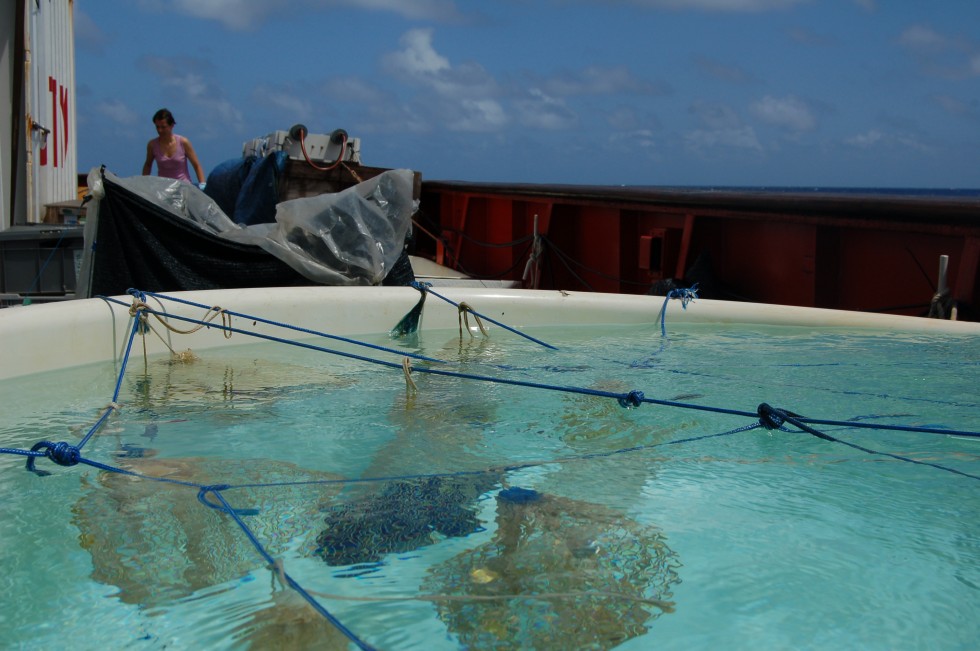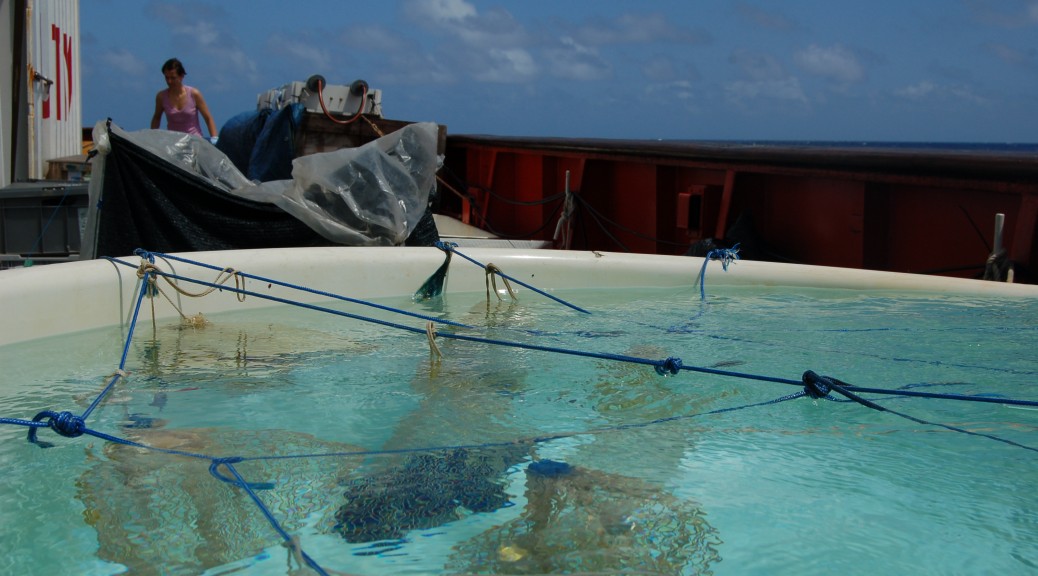S 30° 03’ 13″ E 61° 28’ 50″ – On Sunday the researchers aboard the Hespérides woke to frothing waves rushing past their portholes. The ship had rocked and rolled through the night, but it had not stopped for its normal pre-dawn observations because the sea was too rough. Sunday would be the first of four days when the scientific staff took a forced partial break.
It is too risky to lower the sampling rosetta or other bottles and nets when at one moment the guardrail appears to tower over the foaming breakers below and at the next the cerulean water rushes onto the deck. A sudden pitch has been known to snap cables holding sampling instruments or to send a careless journalist sprawling on a gritty deck.Instead of taking new observations, many of the researchers on the Hespérides spent the last few days analysing old data, catching up on sleep, and watching movies in the scientists’ lounge.
Still, not everyone gets to ignore work in rough seas. Alexandra Steckbauer, a graduate student at the CSIC’s Mediterranean Institute for Advanced Studies (IMEDEA) in Mallorca, was in her laboratory Sunday morning shuffling bottles between sinks. Earlier that morning, she had ventured out on deck in the wind and incessant pitching to collect water from incubation tubes which the day before she had filled with water from three depths: 3 metres, the depth that gets 20% of the surface light, and the deep chlorophyll maximum (DCM), a point around 60 to 100 metres below the surface where the amount of nutrients rising from the deep and light filtering in from above combine to create a spike in chlorophyll.
Steckbauer and two colleagues normally make several daily rounds of their incubating tubes, trying to ensure that the temperature of the water and the light levels are the same as at the depth each sample was collected. They are cultivating phytoplankton, which oceanographers call “primary producers.” The label refers to their plant-like ability to perform photosynthesis, making them ideal snacks for zooplankton and by proxy, everything else that lives in the ocean. Phytoplankton also come in handy to the planet if they escape predators because when they die they take with them the carbon they’ve trapped during photosynthesis on their downward journey to the seafloor. “There are estimates that they account for almost half of the planet’s photosynthesis, but we’re trying to make actual measurements,” says microbiologist Natalia Gonzalez, of the University of King Juan Carlos in Madrid, who also has incubations on the Hespérides.
Phytoplankton also come in handy to the planet if they escape predators because when they die they take with them the carbon they’ve trapped during photosynthesis on their downward journey to the seafloor. “There are estimates that they account for almost half of the planet’s photosynthesis, but we’re trying to make actual measurements,” says microbiologist Natalia Gonzalez, of the University of King Juan Carlos in Madrid, who also has incubations on the Hespérides.
Measuring the performance of phytoplankton is only the first step: Gonzalez and others are also exposing their captured phytoplankton to varying levels of ultraviolet light and adjusting other environmental factors to measure how the plankton’s productivity changes with different nutrient levels or temperatures, for example.
Since the ocean’s acidity is changing, researchers are also trying to get a preview of how that might affect the ecological pyramid that rests on phytoplankton. In a lively after-dinner discussion one night, Gonzalez and others debated the meaning of contradictory studies, some of which have found improved carbon-capturing efficiency in phytoplankton exposed to more acidic waters, and others which found the opposite effect. Translating such studies into real-world predictions is complicated by the fact that after enough reproductive cycles, phytoplankton may very well evolve to fit new ocean conditions.
Still, the phytoplankton do not seem to appreciate the care lavished on them by Steckbauer and her colleagues. Even in the tightly-controlled conditions of the incubation tubes few phytoplankton live more than a day or so. In a sense, the researchers are prolonging deaths, rather than cultivating living things. But everything from the size of the phytoplankton to their genetic composition to the oxygen content of their dying breaths tells researchers something about how much carbon they can expect the sea to trap in the future. And given how much additional carbon we are emitting into the environment, it seems worth knowing what effect it might have on the ocean.
So the Malaspina researchers are trying to measure the living things which trap carbon dioxide, the embodiment of our collective breath. But for a few days while they rode out a windstorm south of Madagascar, the researchers on the Hespérides paused from catching society’s breath to catch their own.
Previous posts in this series:
Malaspina expedition: Data deluge (21 February 2011)
Malaspina expedition: Water, water everywhere and not a drop to sample (17 February 2011)
Malaspina expedition: Starting out with a splash (14 February 2011)
Malaspina expedition: Shipping out (11 February 2011)
Images: The prow of the Hespérides crashing through waves on a windy day; Natalia Gonzalez of the University of King Juan Carlos and an incubation pool on deck on a sunny day. / Lucas Laursen. Map indicates approximate location of dispatches.
First published on Nature’s The Great Beyond blog [html]
